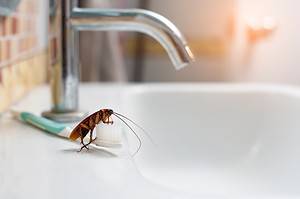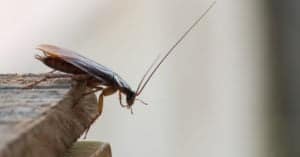In North Carolina, as in other states, you can find all kinds of pests. Among North Carolina’s most common pests is the cockroach. A well-kept home can easily become infested by them even if it has been thoroughly cleaned. The reason for this is that roaches are found in enormous numbers throughout the state. It is also due to their incredible resilience that they infest areas so effectively. For example, it is possible for them to live without their heads for days at a time. It has even been mentioned that they can survive a nuclear fallout. In general, roaches are fairly well-known insects that continue to cause havoc all over the world.
Throughout this article, we’ll look at the most common species of roaches in North Carolina. Learn how to identify the most common roaches in the state, how to keep them at bay, and more.
The Most Common Species of Roaches in North Carolina
The state of North Carolina has several different types of roaches. While all roaches have similar general characteristics, they also differ in a number of important ways. Since roaches have different kinds of characteristics, it can be helpful to know how to distinguish them. There are several types of roach species found throughout the state, but we’re going to focus on five species that are most prevalent. After all, these are the ones that you’re probably most likely going to encounter.
German Cockroaches

German roaches are the most common roaches found in North Carolina.
©IrinaK/Shutterstock.com
As far as cockroaches go, German cockroaches are the most common ones found in North Carolina. Both urban and rural areas of North Carolina are home to German cockroaches. You know you’re dealing with a German roach because they are small, brown, and have two dark stripes running down horizontally on their backs. In adulthood, German cockroaches can grow to be anywhere between ½ to 5/8th of an inch. Due to their small size, they are very invasive species and become quite established in a short period of time. To gain access to structures, they will squeeze their bodies through even the tiniest of cracks and holes.
Despite having wings, both male and female German roaches do not fly often, if ever. Instead, their way of traveling consists of running very quickly. The German cockroach eats both plant and animal matter, making it an omnivore. These cockroaches will gather food from dead plants and dead insects in the wild. Food sources like garbage cans and food for pets are also attractive to these cockroaches. They are nocturnal insects that are active at night. These cockroaches avoid light during the day by hiding in tight spaces. It is not unusual to find German cockroaches in bathrooms and kitchens since they are drawn to home environments with humidity and heat.
American Cockroaches
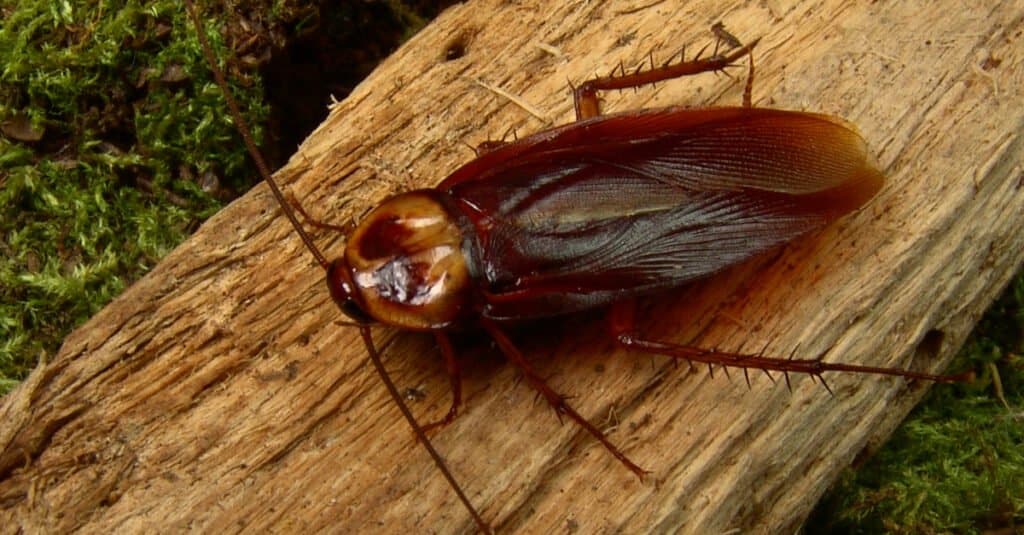
American roaches are also known as palmetto bugs.
©skifbook/Shutterstock.com
The American cockroach, or palmetto bug, is pretty common throughout North Carolina. They are actually the largest cockroaches you can find in the state, and they are some of the biggest in the country. It is possible for them to reach a length of more than 3 inches. They are, however, more likely to grow anywhere between 1 1/2 to about 2 inches long.
In addition to their dark reddish brown color, American roaches have a lighter color lining around their bodies. Their heads are also adorned with a yellow-colored pattern in the shape of a figure-8. Both male and female American roaches can fly because their wings are longer than their bodies. Even though they can run quite fast, they can also fly quite short distances. They prefer moist, warm temperatures, so they often live in sewers, crawl spaces, and basements.
Brown-Banded Cockroaches
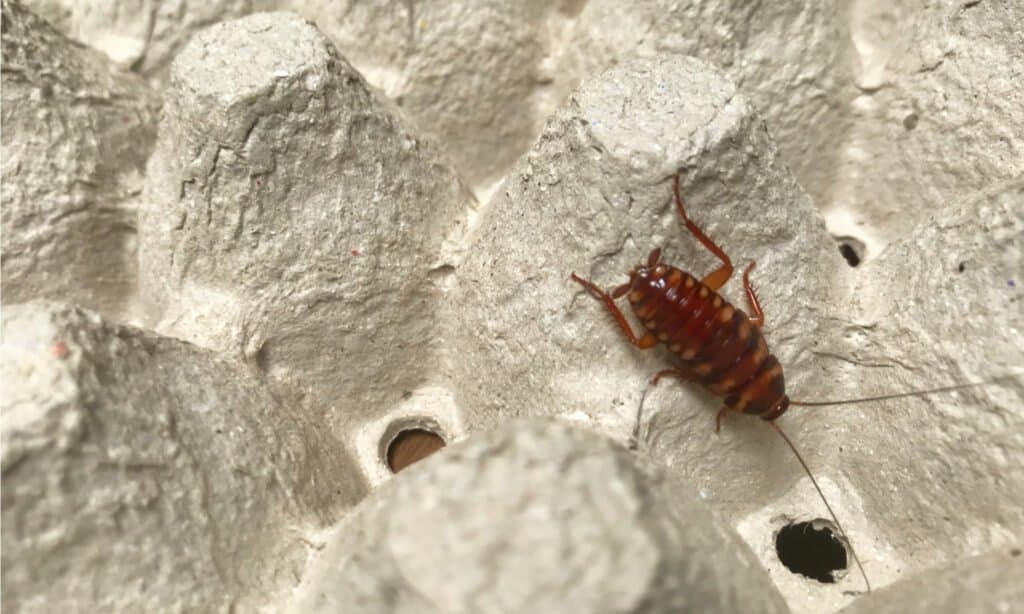
Brown-banded roaches get their name from the bands that run across their bodies.
©Freedom my wing/Shutterstock.com
The brown-banded cockroach is another small roach that can be found in North Carolina.
Despite being less common than other species in North Carolina, brown-banded cockroaches are found in all 100 counties of the state. They reach a length of approximately 1/2 an inch once they reach adulthood. Their color ranges from light brown to dark brown, and two lighter bands run across their bodies behind the head. It is common for the females of the species to have shorter and bigger bodies than males. In contrast to males, females are incapable of flying.
However, since the males are good flyers, these cockroaches are usually found high up on walls and in cabinet tops. Generally, they will not hang out near the sink or fridge since they prefer warm and dry environments. A common habitat for these cockroaches is usually a house, hotel, apartment building, and even office building. Also, they do not mind eating scraps around your home and will not be picky about what they eat.
Cuban Cockroaches
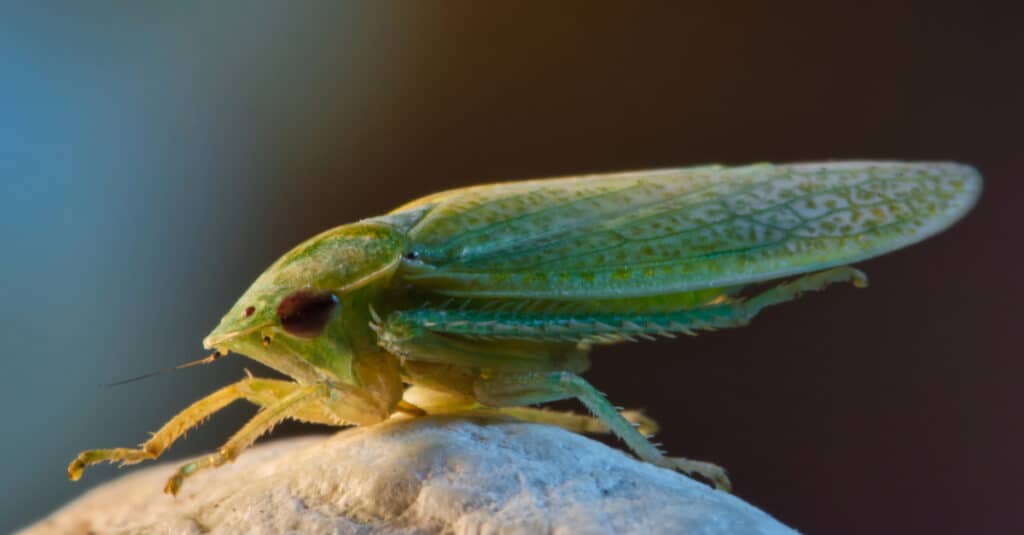
Adult Cuban roaches are green in color to help them camouflage in trees.
©Gill_figueroa/Shutterstock.com
It is pretty common to see Cuban cockroaches throughout North Carolina. This roach originated in Cuba or the Caribbean islands, as its name suggests. Unlike other roaches, Cuban roaches are attracted to light and can fly very well. Typically, Cuban roaches grow from one to two inches in length. Adults tend to be pale green in color and have fully developed wings and antennae. However, their nymphs are brown or black in color. The difference in color between the adults and nymphs actually serves an evolutionary purpose.
Tree canopies are usually home to the adults, while the ground is home to the nymphs. In both adult and nymph forms, their coloration functions as camouflage. As a result of the green color, the adults can better disguise themselves in the trees. In the meantime, the nymphs perfectly blend into the landscape of the soil. In your home, you can usually find them in stoves, heaters, and other warm places.
Oriental Cockroaches
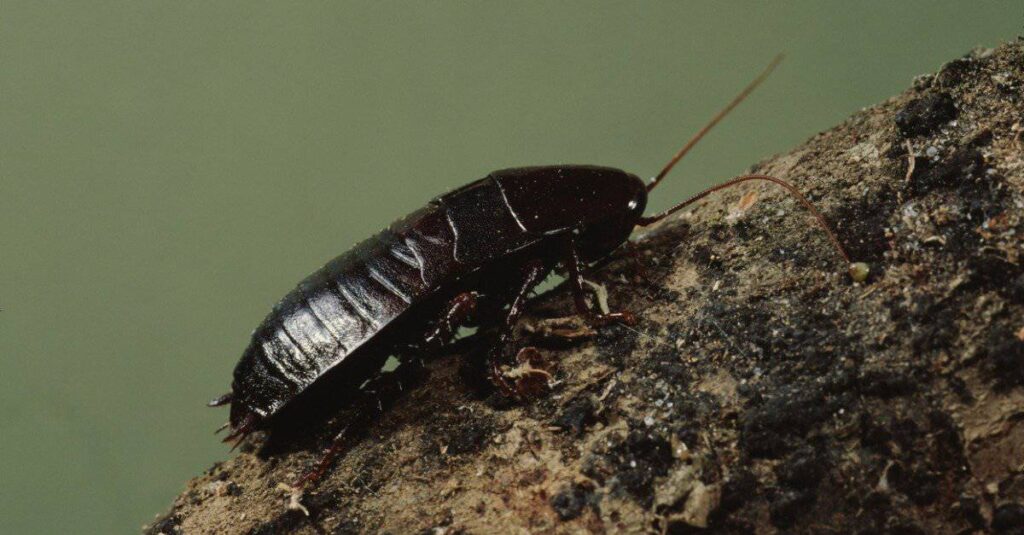
Water bugs, or oriental roaches, love dark and damp environments.
©iStock.com/Weber
Due to their preference for dark, damp, and cool environments, oriental roaches are often called water bugs. Size is what immediately sets this roach apart from the rest. It is estimated that adults grow to be about one inch long. However, aside from being fairly large roaches, Oriental roaches are also a fairly common species in North Carolina. In terms of their appearance, you will often be able to identify them because of their smooth and shiny black bodies.
It is also important to note that these roaches emit an unpleasant odor, which is both mildewed and pungent. Although both sexes have wings, neither is capable of flying.
Why Does North Carolina Have So Many Cockroaches?
Let’s learn why North Carolina is so flooded with roaches now that we know which ones are most common to see. The high cockroach population in North Carolina can be attributed to a few factors. There are several reasons why cockroaches flourish in this state, including the humid climate, which they love. The warm weather provides them with a suitable habitat for living. Since roaches are cold-blooded, they are better suited to live in a warm, humid environment. It has been found that the warmer it is, the faster the reproduction cycle can be completed by roaches.
There is another reason for the large number of roaches in the area as well, which is the fact that roaches have many different food sources available to them. Cockroaches are also attracted to North Carolina due to a large number of trees and other vegetation that provide a haven for them. No matter where they live in North Carolina, roaches can find shelter since it has both metropolises and rural areas.
When Are Cockroaches the Most Active in North Carolina?
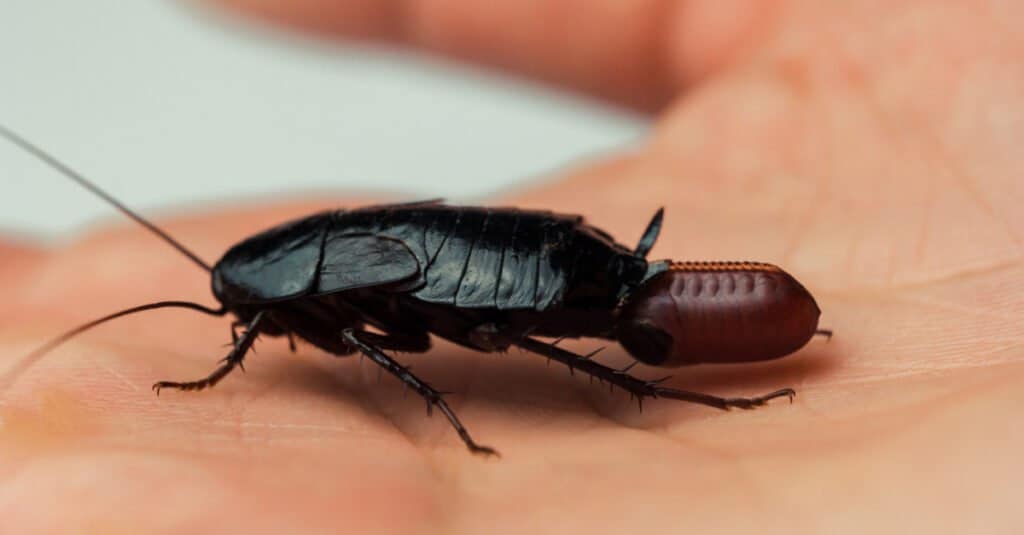
Summer is the most active time of the year for cockroaches.
©Yuliia Hurzhos/Shutterstock.com
Is there a season when roaches are the most active? Surprisingly, yes. Summer is the most active time of the year for cockroaches. This is because roaches are cold-blooded insects that depend on the warm weather to be able to move about and reproduce. There will be fewer roaches in colder climates during winter since many species will hibernate or die. When the weather warms up in spring and summer, they reappear. There is a continuous presence of roaches in the southern US and southern California states throughout the year due to their warm climates. Because of this, roaches are active throughout the year in North Carolina, where the temperatures never get that cold.
Lifespan
The life cycle of the cockroach typically consists of three stages. In the first stage, eggs are laid in a hardened egg case. After a few days to weeks, the nymphs hatch from the eggs and begin their development into adults. This process can take up to 600 days or more, depending on temperature and food availability. If they have everything they need to survive, they typically live for twenty or thirty weeks. During this time, they molt several times by shedding their exoskeleton until they reach adulthood. Adult cockroaches can live for another year or two as long as food and water are available, after which point they will die naturally due to old age.
Roach Predators: What Eats Roaches in North Carolina?
In order for the ecosystem to function properly, cockroaches play an important role. Although some roaches die naturally, many more end up as meals for predators. There are several animals that eat roaches in North Carolina. Cockroaches in North Carolina are often preyed on by toads and frogs. In fact, cockroaches are a favorite food of both of these amphibians, as well as flies, which they seek out in abundance.
Cockroaches are one of the insects that many lizards eat. Various other lizard species, like bearded dragons and monitor lizards, feed on cockroaches. Cockroaches are also sometimes eaten by mammals. It is well known that opossums, for example, eat various things. Whether it is garbage, carrion, or insects such as roaches, they eat it all! Furthermore, rats are also notorious for eating almost anything, and they are not opposed to eating insects such as cockroaches.
How To Get Rid of Roaches in North Carolina?

Cockroaches are difficult to get rid of in homes, but measures can be taken to eliminate them.
©IrinaK/Shutterstock.com
If you’re anything like most people, the very sight of a cockroach is enough to make the hair on the back of your neck stand on end. North Carolina is home to a lot of these annoying insects, so chances are, if you live there, you’ve seen your fair share of them at some point. In general, cockroaches are not a health risk, but some people can be allergic to them or contract diseases from them. Cockroaches are difficult to get rid of in homes, but you can take some measures to eliminate them.
The first thing you should look into is baits and traps. In some cases, cockroach baits are formulated with chemicals that attract the cockroaches and entice them into the trap. As soon as they are inside, the cockroaches cannot escape and eventually die due to their inability to escape. Most hardware stores or online retailers have baits and traps available for you to find at a reasonable price. Insecticides are another great option for getting rid of roaches. When in contact with insects, insecticides kill them. Insecticides come in a wide variety of formulations, so make sure to get the right one for your specific problem.
If you find that the problem is beyond your control, you may want to seek professional help in order to resolve the issue. Getting rid of roaches in your home or business with the help of a professional exterminator is the best way to get rid of the problem if it has gotten out of control.
Cockroach Versus Beetle: What is the Difference?
The main difference between a cockroach and a beetle is that cockroaches are insects, while beetles belong to the Coleoptera order. A further difference lies in their appearance; cockroaches have flattened oval bodies with long antennae and six legs, whereas beetles have hard protective wings that cover their bodies and short antennae.
Additionally, cockroaches can fly, but beetles typically do not. Cockroaches also tend to be more active at night than during the day, while beetles operate mostly during daylight hours. Finally, another key distinction between these two creatures is that many species of cockroaches are considered pests due to their destructive behavior, whereas most species of beetle pose little threat or risk to humans and our environment.
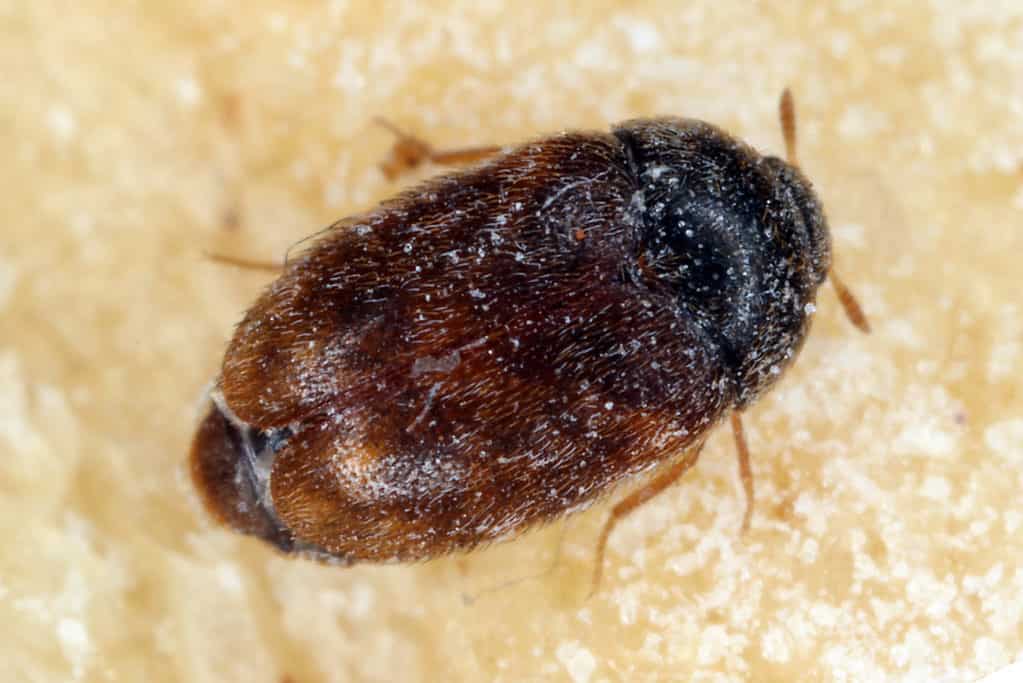
Khapra beetle is a pest that hides in stored grain and is often mistaken for a cockroach.
©iStock.com/Tomasz Klejdysz
What Insects are Mistaken for Cockroaches?
Many other insects are mistaken for cockroaches due to their similar appearance. Red flour beetles, drugstore beetles, and cigarette beetles all resemble cockroaches in shape and size, but they typically have different coloration. Silverfish also look like a small version of a cockroach and can be found in bathrooms or kitchens where there is moisture present. Stink bugs are sometimes mistaken for cockroaches as well since they both possess flattened bodies with long antennae.
Other common bugs mistaken for cockroaches include crickets, giant water bugs, and June beetles (also known as May beetles or June bugs). Another insect that is frequently mistaken for a cockroach is the Asian Longhorned Beetle. This beetle has black and white striped antennae, which can be easily confused with the antennas of a cockroach.
Up Next:
The photo featured at the top of this post is © Brett Hondow/Shutterstock.com
Thank you for reading! Have some feedback for us? Contact the AZ Animals editorial team.




